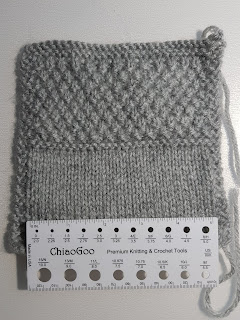Knitting a swatch and checking your gauge are essentials for almost every knitting project. Many knitters ignore this task and jump to cast on as soon as possible. As a result, they can have a wrong size garment or get very stiff/loose fabric.
So, knitting a swatch can help you:
- Choose a correct size of knitting needles and the knitted fabric will look beautiful.
- To get a right size of the finished garment.
Knitting pattern’s gauge is determined by the designer and can be slightly different from the gauge recommended by the yarn’s manufacturer. You need to follow the designer’s gauge in order to get the correct size of the finished garment.
Also the gauge depends on many other factors such as: personal knitting gauge (some knitters knit loose while the others - tight), yarn type and fibre content, knitting needles material and shape. Some yarn will change its size after washing. So, even if you knit with the yarn recommended in the pattern it is still essential to knit your own swatch and make sure that it matches the pattern one.
Swatch Knitting Tips:
1. Knit a swatch with the yarn you plan to knit your project with.
2. Knit a swatches for all stitches used in a pattern if it is recommended by the designer.
3. Do not knit a tiny swatch. The size of your swatch should be at least 10 cm/4 inch.
4. Block your swatch before taking your measurements.
5. Knit your swatch in the round if the garment you going to knit is knitted on circular needles seamlessly.
Knitting Gauge problems:
If a gauge of your swatch matches the recommended gauge for both stitches and rows you can cast on your project and enjoy knitting. If your swatch doesn’t meet the gauge you need to adjust the knitting needle size or in rare cases to change the yarn.
- If you’ve got more stitches per 10 cm/4” (your stitches are too small) than you need to knit another swatch with bigger needles.
- If you’ve got fever stitches per 10cm/4” (your stitches are too large) than you need to knit another swatch with smaller needles.
Row gauge:
It is more difficult to get the correct row gauge than stitch gauge sometimes. If you’ve got this problem, you can try using wooden needles instead of metal ones and vice-versa. The change in needles material can help sometimes. If even after using of different type of needles the row gauge is still incorrect you need to change the yarn.
However, if the pattern instructions are based on length measurement and not quantity of rows you can ignore the row gauge.
Get swatching :)
So even if you feel this crafty itch in your hands don’t skip this important step and knit your swatch first. It is a great opportunity to try your yarn and test out the stitch especially if you’ve never knitted with it before. It can save your time and give your assurance that your project going to come out correctly.
Happy knitting!!!
So, knitting a swatch can help you:
- Choose a correct size of knitting needles and the knitted fabric will look beautiful.
- To get a right size of the finished garment.
Knitting pattern’s gauge is determined by the designer and can be slightly different from the gauge recommended by the yarn’s manufacturer. You need to follow the designer’s gauge in order to get the correct size of the finished garment.
Also the gauge depends on many other factors such as: personal knitting gauge (some knitters knit loose while the others - tight), yarn type and fibre content, knitting needles material and shape. Some yarn will change its size after washing. So, even if you knit with the yarn recommended in the pattern it is still essential to knit your own swatch and make sure that it matches the pattern one.
Swatch Knitting Tips:
1. Knit a swatch with the yarn you plan to knit your project with.
2. Knit a swatches for all stitches used in a pattern if it is recommended by the designer.
3. Do not knit a tiny swatch. The size of your swatch should be at least 10 cm/4 inch.
4. Block your swatch before taking your measurements.
5. Knit your swatch in the round if the garment you going to knit is knitted on circular needles seamlessly.
Knitting Gauge problems:
If a gauge of your swatch matches the recommended gauge for both stitches and rows you can cast on your project and enjoy knitting. If your swatch doesn’t meet the gauge you need to adjust the knitting needle size or in rare cases to change the yarn.
- If you’ve got more stitches per 10 cm/4” (your stitches are too small) than you need to knit another swatch with bigger needles.
- If you’ve got fever stitches per 10cm/4” (your stitches are too large) than you need to knit another swatch with smaller needles.
Row gauge:
It is more difficult to get the correct row gauge than stitch gauge sometimes. If you’ve got this problem, you can try using wooden needles instead of metal ones and vice-versa. The change in needles material can help sometimes. If even after using of different type of needles the row gauge is still incorrect you need to change the yarn.
However, if the pattern instructions are based on length measurement and not quantity of rows you can ignore the row gauge.
Get swatching :)
So even if you feel this crafty itch in your hands don’t skip this important step and knit your swatch first. It is a great opportunity to try your yarn and test out the stitch especially if you’ve never knitted with it before. It can save your time and give your assurance that your project going to come out correctly.
Happy knitting!!!
















